Whatever Happened to the Wetbike?
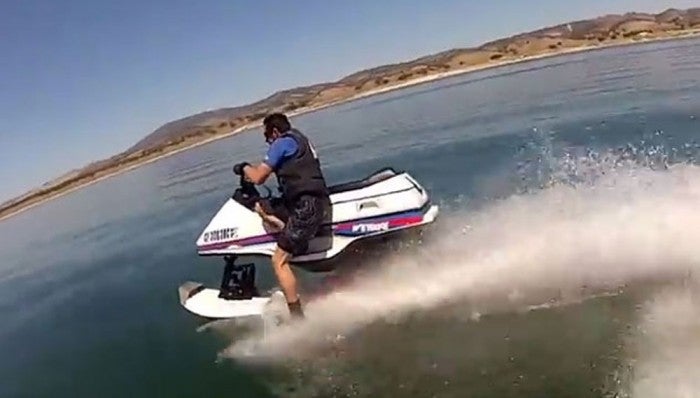
A look back at some PWC history
Today, personal watercraft have become a common sight on waterways across the world, but in the sport’s early days they were a novelty, that cool toy a neighbor may have had, or more likely, something you only saw on television or the movies. But while two of the first craft on the scene – the original Sea-Doo and the standup Kawasaki Jet Ski – essentially still live on in more modern forms, a third vehicle – the Wetbike – has faded into relative obscurity.
Let’s take a look back at one of the original personal watercraft.
Front Steering
The Wetbike was introduced in 1978, just several years behind the Kawasaki Jet Ski and nearly a decade before the runabouts we’re familiar with today followed. Produced by Spirit Marine (a subsidiary of Arctic Enterprises, now Arctic Cat, which would later produce the Tigershark brand), the original Wetbike was billed as a motorcycle-like craft. And in many ways, it was far more like a motorcycle than any of the craft that followed.
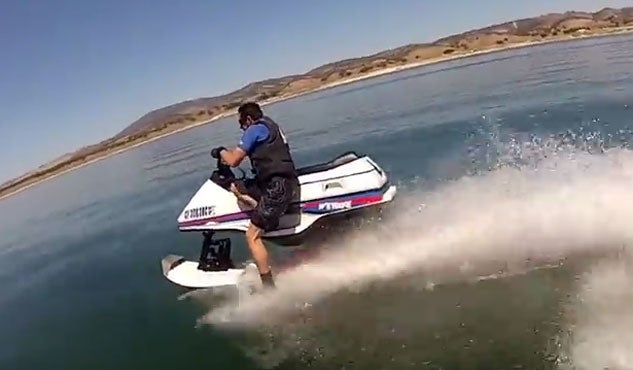 The Wetbike looks and handles more like a motorcycle than any other personal watercraft. (Image taken from video by West Coast Wetbikes)
The Wetbike looks and handles more like a motorcycle than any other personal watercraft. (Image taken from video by West Coast Wetbikes)The bulk of the craft was made up by a somewhat wedge-shaped body, with angular nose and bulkier aft end. At rest, the craft could vaguely resemble a stubbier version of the sit-down craft that would soon ignite the industry. Handlebars, tether-style ignition switch, and relatively flat seat distinguished the craft’s upper half. Below, simple open footwells waited just below the waterline.
Any similarities, however, faded once the craft got under power. The Wetbike’s most unique characteristic was how it rode through the water. Rather than skim across the waves on a hull and be steered from the rear via a pivoting blast of thrust, the Wetbike rose up above the surface and skimmed across the water on two large “skis.” Unlike other personal watercraft, before or since, steering came not from a jet-pump directional nozzle – the jet pump was fixed and located atop the rear ski. Rather, the shorter front ski could actually turn within a 90-degree arc, mimicking the action of a motorcycle or bicycle’s front wheel. This steerable front ski, linked to the Wetbike’s body via a linked suspension, resulted in a vastly different ride feel than anything else that would ever hit the market. You could actually lean into turns, but there was a brief learning curve. On my first attempt at a wetbike, I felt like the craft counter steered until I truly got the hang of it.
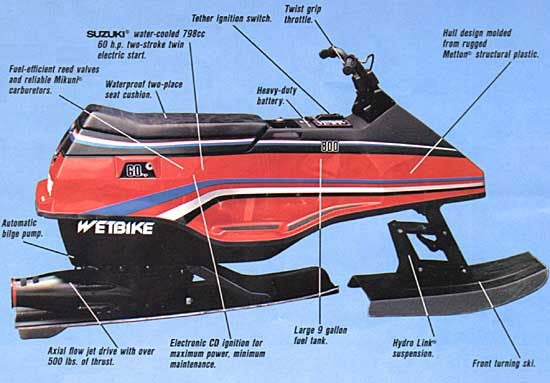 The motorcycle-like feel was even echoed in the throttle. Rather than the trigger-style that has become the norm in the market, the Wetbike’s throttle was a twist grip.
The motorcycle-like feel was even echoed in the throttle. Rather than the trigger-style that has become the norm in the market, the Wetbike’s throttle was a twist grip.Horsepower…To Spare?
Similar to today’s craft, the Wetbike’s engine could be found below the saddle. Originally, it was a 50hp Spirit reed-valve engine, with a displacement of 723cc, dual Mikuni carburetors, and electronic CD ignition. By 1986, that engine had grown to an 800cc Suzuki motor capable of 60 hp. What kind of speeds could Wetbike owners expect? They were impressive…for the time. Early models topped out at about 32 mph; later, top speeds increased to 36 mph. The craft could be expected to rise up and plane on its dual skis between 11-15 mph. Speeds in those later years would also be aided by the switch to a lightweight Metton plastic body.
High Profile…Short Life Span
For a brief period, the Wetbike enjoyed a high profile. In 1977, James Bond famously rode one (a loaner from the gadget-happy Q) across the ocean and into the villain’s submergible lair in The Spy Who Loved Me. The craft was actually the original Wetbike prototype. CHiPs fans may also remember Ponch and Jon enjoying Wetbikes before chasing down the bad guys. Wetbikes continued to be seen in Police Academy 3, and as recently as the 1990 George Clooney-movie Red Surf.
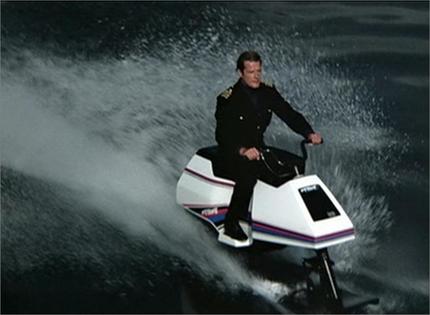 Even James Bond rode a Wetbike.
Even James Bond rode a Wetbike.Sadly for fans, however, the Wetbike never truly caught on. By 1992 it was history, replaced by the easier-to-ride – and easier to transport – PWC that had recently come on the scene from a variety of major manufacturers like Kawasaki, Sea-Doo, and Yamaha.
Its legacy, however, lives on in many ways. Take that suspension. The idea of cushioning the ride in waves made it into a variety of Sea-Doo models, including the HX and XP, before really expanding with the brand’s Intelligent Suspension concept. The Wetbike’s inside-lean, motorcycle-like feel would also later become the norm across the industry. Even the tether-style ignition would later be adopted throughout the industry. And the idea of going with a plastic body to reduce weight…I seem to recall a recent model doing just that.
Like most things, the internet has kept the Wetbike alive as well. Just search YouTube…you’ll find the Wetbike still has plenty of loyal fans.
Like this guy…
Get PersonalWatercraft.com in your Inbox!
Like PersonalWatercraft.com on Facebook
Comments
Most Popular

Remembering the Sea-Doo XP

2025 Yamaha JetBlaster PRO 2-Up Review

2024 Yamaha GP HO Review

2024 Kawasaki Jet Ski STX 160X Review

2017 Kawasaki Jet Ski Ultra 310LX Review
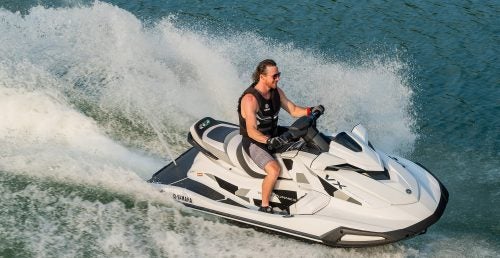










 Your Privacy Choices
Your Privacy Choices